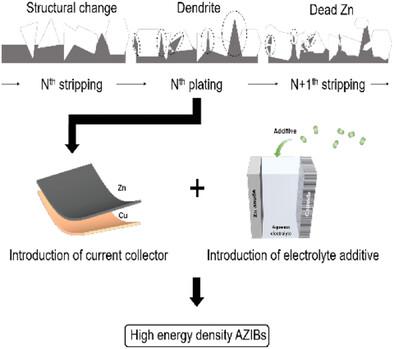Our official English website, www.x-mol.net, welcomes your
feedback! (Note: you will need to create a separate account there.)
Overcoming Challenges: Extending Cycle Life of Aqueous Zinc-Ion Batteries at High Zinc Utilization through a Synergistic Strategy
Small ( IF 13.0 ) Pub Date : 2023-10-17 , DOI: 10.1002/smll.202308273 Xin Xu 1 , Xiang Feng 1 , Mingyan Li 1 , Junyi Yin 1 , Jingzhe Chen 1 , Fuxiang Li 1 , Weichen Shi 1 , Yonghong Cheng 1 , Jianhua Wang 1
Small ( IF 13.0 ) Pub Date : 2023-10-17 , DOI: 10.1002/smll.202308273 Xin Xu 1 , Xiang Feng 1 , Mingyan Li 1 , Junyi Yin 1 , Jingzhe Chen 1 , Fuxiang Li 1 , Weichen Shi 1 , Yonghong Cheng 1 , Jianhua Wang 1
Affiliation

|
Aqueous zinc-ion batteries (AZIBs) face challenges in achieving high energy density compared to conventional lithium-ion batteries (LIBs). The lower operating voltage and excessive Zn metal as anode pose constraints on the overall energy storage capacity of these batteries. An effective approach is to reduce the thickness of the Zn metal anode and control its mass appropriately. However, under the condition of using a thin Zn anode, the performance of AZIBs is often unsatisfactory. Through experiments and computational simulations, the electrode structural change and the formation of dead Zn as the primary reasons for the failure of batteries under a high Zn utilization rate are identified. Based on this understanding, a universal synergistic strategy that combines Cu foil current collectors and electrolyte additives to maintain the structural and thermodynamic stability of the Zn anode under a high Zn utilization rate (ZUR) is proposed. Specifically, the Cu current collectors can ensure that the Zn anode structure remains intact based on the spontaneous filling effect, while the additives can suppress parasitic side reactions at the interface. Ultimately, the symmetric cell demonstrates a cycling duration of 900 h at a 70% ZU, confirming the effectiveness of this strategy.
中文翻译:

克服挑战:通过协同策略延长高锌利用率的水系锌离子电池的循环寿命
与传统锂离子电池(LIB)相比,水系锌离子电池(AZIB)在实现高能量密度方面面临挑战。较低的工作电压和过量的锌金属作为阳极对这些电池的整体储能容量造成了限制。有效的方法是减小Zn金属阳极的厚度并适当控制其质量。然而,在使用薄锌阳极的条件下,AZIBs的性能往往不能令人满意。通过实验和计算模拟,确定了电极结构变化和死锌的形成是高锌利用率下电池失效的主要原因。基于这一认识,提出了一种通用的协同策略,将铜箔集流体和电解质添加剂相结合,以在高锌利用率(ZUR)下保持锌负极的结构和热力学稳定性。具体来说,Cu集流体可以基于自发填充效应确保Zn负极结构保持完整,而添加剂可以抑制界面处的寄生副反应。最终,对称电池在 70% ZU 下表现出 900 小时的循环持续时间,证实了该策略的有效性。
更新日期:2023-10-17
中文翻译:

克服挑战:通过协同策略延长高锌利用率的水系锌离子电池的循环寿命
与传统锂离子电池(LIB)相比,水系锌离子电池(AZIB)在实现高能量密度方面面临挑战。较低的工作电压和过量的锌金属作为阳极对这些电池的整体储能容量造成了限制。有效的方法是减小Zn金属阳极的厚度并适当控制其质量。然而,在使用薄锌阳极的条件下,AZIBs的性能往往不能令人满意。通过实验和计算模拟,确定了电极结构变化和死锌的形成是高锌利用率下电池失效的主要原因。基于这一认识,提出了一种通用的协同策略,将铜箔集流体和电解质添加剂相结合,以在高锌利用率(ZUR)下保持锌负极的结构和热力学稳定性。具体来说,Cu集流体可以基于自发填充效应确保Zn负极结构保持完整,而添加剂可以抑制界面处的寄生副反应。最终,对称电池在 70% ZU 下表现出 900 小时的循环持续时间,证实了该策略的有效性。

































 京公网安备 11010802027423号
京公网安备 11010802027423号